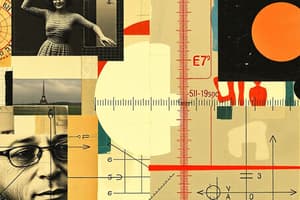Podcast
Questions and Answers
Which branch of science focuses on the study of matter, energy, and their transformations?
Which branch of science focuses on the study of matter, energy, and their transformations?
- Chemistry
- Physics (correct)
- Mathematics
- Biology
What is the primary function of measurement in engineering?
What is the primary function of measurement in engineering?
- To ensure chemical accuracy
- To verify biological laws
- To assure quality of products (correct)
- To improve mathematical techniques
What do you call physical quantities that do not depend on other quantities for their measurement?
What do you call physical quantities that do not depend on other quantities for their measurement?
- Mathematical quantities
- Fundamental physical quantities (correct)
- Chemical quantities
- Derived physical quantities
How many fundamental physical quantities are recognized in physics?
How many fundamental physical quantities are recognized in physics?
Which of the following is an example of a derived physical quantity?
Which of the following is an example of a derived physical quantity?
What do we call the unit associated with a fundamental physical quantity?
What do we call the unit associated with a fundamental physical quantity?
What is the dimensional formula of thermal conductivity?
What is the dimensional formula of thermal conductivity?
The measurements of electric current, thermodynamic temperature, and luminous intensity fall under which category?
The measurements of electric current, thermodynamic temperature, and luminous intensity fall under which category?
Which of the following measurements has the correct number of significant figures?
Which of the following measurements has the correct number of significant figures?
Which of these options describes the significance of measurement in science?
Which of these options describes the significance of measurement in science?
In which unit are substances with larger masses usually measured?
In which unit are substances with larger masses usually measured?
Which type of unit is used for derived physical quantities?
Which type of unit is used for derived physical quantities?
Which instrument provides a higher accuracy level than a mechanical watch?
Which instrument provides a higher accuracy level than a mechanical watch?
Length, mass, and time are classified as which type of quantities?
Length, mass, and time are classified as which type of quantities?
What is the SI unit of area?
What is the SI unit of area?
What is the common name for the single system of units all scientists worldwide agree upon?
What is the common name for the single system of units all scientists worldwide agree upon?
How accurate is the digital reading of an electronic stopwatch?
How accurate is the digital reading of an electronic stopwatch?
What is the unit of Force and its symbol?
What is the unit of Force and its symbol?
Which yantra is used to measure the hour angle of the sun?
Which yantra is used to measure the hour angle of the sun?
Which yantra is developed to find the inclination of planets and stars?
Which yantra is developed to find the inclination of planets and stars?
Who developed the Phalak Yantra for measuring hour angle?
Who developed the Phalak Yantra for measuring hour angle?
What is the shape of the Phalak Yantra?
What is the shape of the Phalak Yantra?
What term describes the angle between the line joining an observer to the sun and the horizontal plane on Earth?
What term describes the angle between the line joining an observer to the sun and the horizontal plane on Earth?
Which of the following is NOT a characteristic of a good unit?
Which of the following is NOT a characteristic of a good unit?
Units are classified into how many groups?
Units are classified into how many groups?
What is a set of fundamental and derived units known as?
What is a set of fundamental and derived units known as?
Which physical quantity has the same unit in all systems of units?
Which physical quantity has the same unit in all systems of units?
How many supplementary units are there in the S.I. system of units?
How many supplementary units are there in the S.I. system of units?
Which unit is NOT considered a fundamental unit?
Which unit is NOT considered a fundamental unit?
What method is used to measure the distance of a planet from the Earth?
What method is used to measure the distance of a planet from the Earth?
Which of the following errors cannot be controlled?
Which of the following errors cannot be controlled?
What is the term that refers to the highest point the sun reaches above our head?
What is the term that refers to the highest point the sun reaches above our head?
The Chakra yantra was historically used for which type of measurement?
The Chakra yantra was historically used for which type of measurement?
Which term is used to refer to the angle in Chakra Yantra between the stick's shadow and the horizontal line?
Which term is used to refer to the angle in Chakra Yantra between the stick's shadow and the horizontal line?
What is the term for the angle between the stick’s top point and its shadow in the Chakra Yantra?
What is the term for the angle between the stick’s top point and its shadow in the Chakra Yantra?
What does the term 'Chaapa' refer to?
What does the term 'Chaapa' refer to?
Which yantra was specifically utilized for measuring the vertical angle?
Which yantra was specifically utilized for measuring the vertical angle?
Which of the following is NOT a type of yantra mentioned for various measurements?
Which of the following is NOT a type of yantra mentioned for various measurements?
In the context of Chakra Yantra, 'Natta' and 'Unnatta' are calculated for which purpose?
In the context of Chakra Yantra, 'Natta' and 'Unnatta' are calculated for which purpose?
Which material is used to cover Davy’s safety lamp?
Which material is used to cover Davy’s safety lamp?
A hot air balloon operates based on which gas law?
A hot air balloon operates based on which gas law?
What is the normal temperature at N.T.P in Kelvin?
What is the normal temperature at N.T.P in Kelvin?
If a gas occupies 40cm³ at 27°C, what would be its volume at 57°C if pressure is constant?
If a gas occupies 40cm³ at 27°C, what would be its volume at 57°C if pressure is constant?
What happens to light when it travels from one medium to another?
What happens to light when it travels from one medium to another?
In refraction, how does light behave when it moves from glass to air?
In refraction, how does light behave when it moves from glass to air?
What are the conditions necessary for Total Internal Reflection (T.I.R.)?
What are the conditions necessary for Total Internal Reflection (T.I.R.)?
What is the sine of the acceptance angle in optical fiber known as?
What is the sine of the acceptance angle in optical fiber known as?
Flashcards
Physics
Physics
The branch of science that studies matter, energy, and their transformations in nature.
Measurement
Measurement
A means of communicating information in engineering and science by assigning numerical values to physical quantities.
Fundamental Physical Quantities
Fundamental Physical Quantities
Physical quantities that don't depend on other quantities for their measurement.
Fundamental Units
Fundamental Units
Signup and view all the flashcards
Derived Physical Quantities
Derived Physical Quantities
Signup and view all the flashcards
Derived Units
Derived Units
Signup and view all the flashcards
Standard Units
Standard Units
Signup and view all the flashcards
Measurement
Measurement
Signup and view all the flashcards
Accuracy
Accuracy
Signup and view all the flashcards
Precision
Precision
Signup and view all the flashcards
Dimensional Formula of Thermal Conductivity
Dimensional Formula of Thermal Conductivity
Signup and view all the flashcards
Significant Figures in Measurements
Significant Figures in Measurements
Signup and view all the flashcards
Unit of large mass
Unit of large mass
Signup and view all the flashcards
Precision of Time Measurement
Precision of Time Measurement
Signup and view all the flashcards
SI Unit of Area
SI Unit of Area
Signup and view all the flashcards
Using Prefixes in SI Units
Using Prefixes in SI Units
Signup and view all the flashcards
Mercury Thermometer
Mercury Thermometer
Signup and view all the flashcards
Sundial: Ancient Time Measurement
Sundial: Ancient Time Measurement
Signup and view all the flashcards
Chakra Yantra
Chakra Yantra
Signup and view all the flashcards
Phalak Yantra
Phalak Yantra
Signup and view all the flashcards
Yasti Yantra
Yasti Yantra
Signup and view all the flashcards
Dhanu Yantra
Dhanu Yantra
Signup and view all the flashcards
Bhaskaracharya
Bhaskaracharya
Signup and view all the flashcards
Good Unit Characteristic
Good Unit Characteristic
Signup and view all the flashcards
Unit Classifications
Unit Classifications
Signup and view all the flashcards
System of Units
System of Units
Signup and view all the flashcards
Time Unit Consistency
Time Unit Consistency
Signup and view all the flashcards
International System of Units (SI)
International System of Units (SI)
Signup and view all the flashcards
Uncontrollable Errors
Uncontrollable Errors
Signup and view all the flashcards
M.K.S. System
M.K.S. System
Signup and view all the flashcards
Zenith
Zenith
Signup and view all the flashcards
Natta
Natta
Signup and view all the flashcards
Unnatta
Unnatta
Signup and view all the flashcards
Khardha
Khardha
Signup and view all the flashcards
Chaapa
Chaapa
Signup and view all the flashcards
Reciprocal
Reciprocal
Signup and view all the flashcards
Davy's Safety Lamp
Davy's Safety Lamp
Signup and view all the flashcards
Hot Air Balloon
Hot Air Balloon
Signup and view all the flashcards
NTP (Normal Temperature and Pressure)
NTP (Normal Temperature and Pressure)
Signup and view all the flashcards
Charles's Law
Charles's Law
Signup and view all the flashcards
Refraction of Light
Refraction of Light
Signup and view all the flashcards
Critical Angle
Critical Angle
Signup and view all the flashcards
Total Internal Reflection (TIR)
Total Internal Reflection (TIR)
Signup and view all the flashcards
Study Notes
Units & Measurements (CO1)
- Physics is the branch of science dealing with matter, energy, and their transformations in nature.
- Measurement is a source of communication in engineering and science.
- Necessity of measurement in science is for identifying and verifying laws.
- Necessity of measurement in engineering is for accurate predictions and product quality assurance.
- Fundamental physical quantities do not depend on other quantities for measurement. These include length, mass, time, electric current, thermodynamic temperature, amount of substance, and luminous intensity.
- Derived physical quantities depend on other quantities for measurement.
- Fundamental units are the units of fundamental quantities in the SI (International System) system.
- Derived units are the units of derived quantities.
- Supplementary physical quantities and their units are plane angle (radian) and solid angle (steradian).
- SI Units are the internationally recognized units of measurement.
- Length (meter - m)
- Mass (kilogram - kg)
- Time (second - s)
- Electric current (ampere - A)
- Thermodynamic temperature (kelvin - K)
- Amount of substance (mole - mol)
- Luminous intensity (candela - cd)
Additional Information
- Magnitude is the numerical value of a physical quantity.
- Unit is a standard quantity used for measuring a physical quantity.
- Supplementary units are not derived from other quantities.
- Accuracy is the closeness of a measured value to the actual value.
- Significant figures are the number of digits in a measurement that carry meaningful information.
Studying That Suits You
Use AI to generate personalized quizzes and flashcards to suit your learning preferences.




